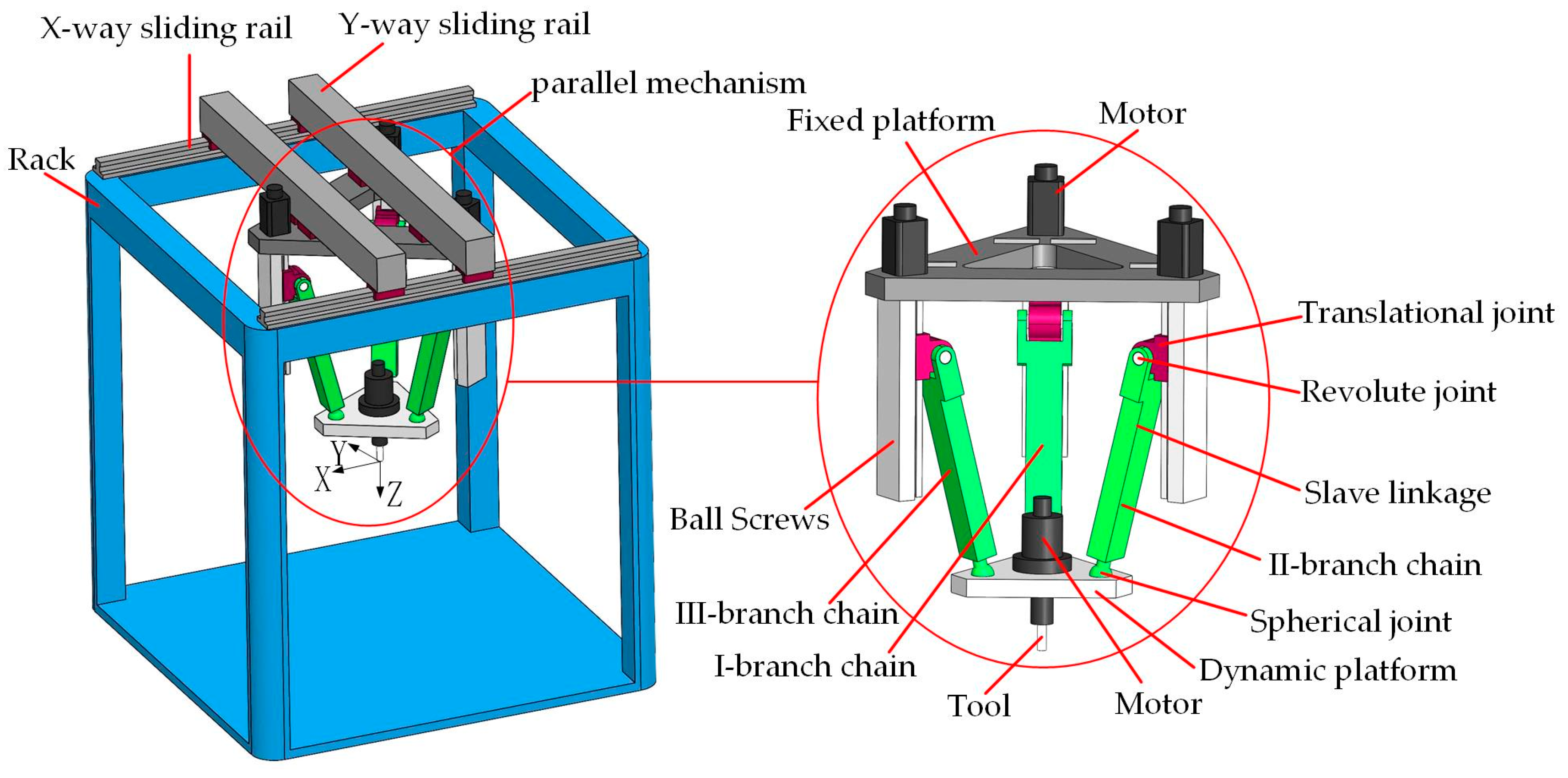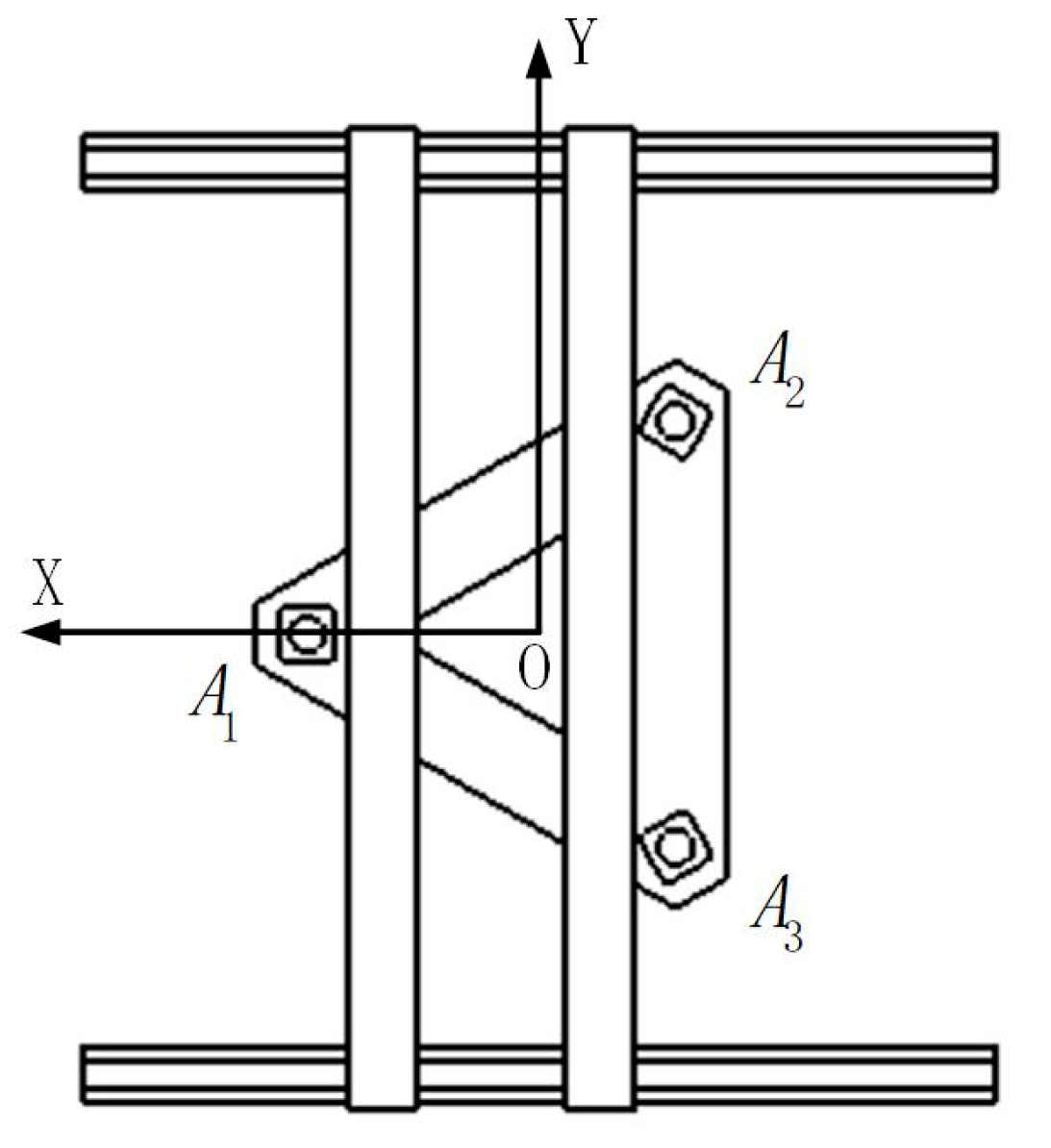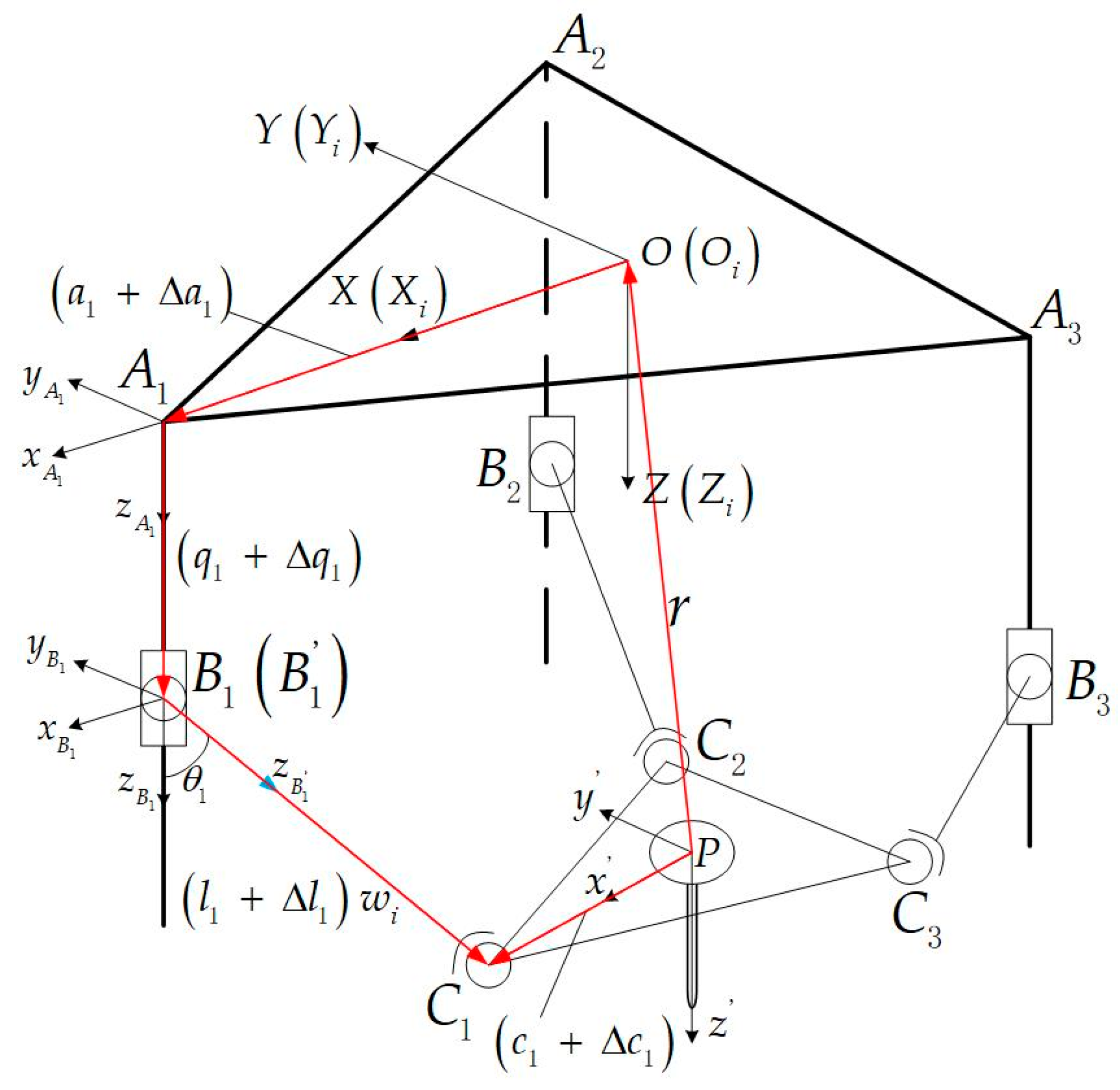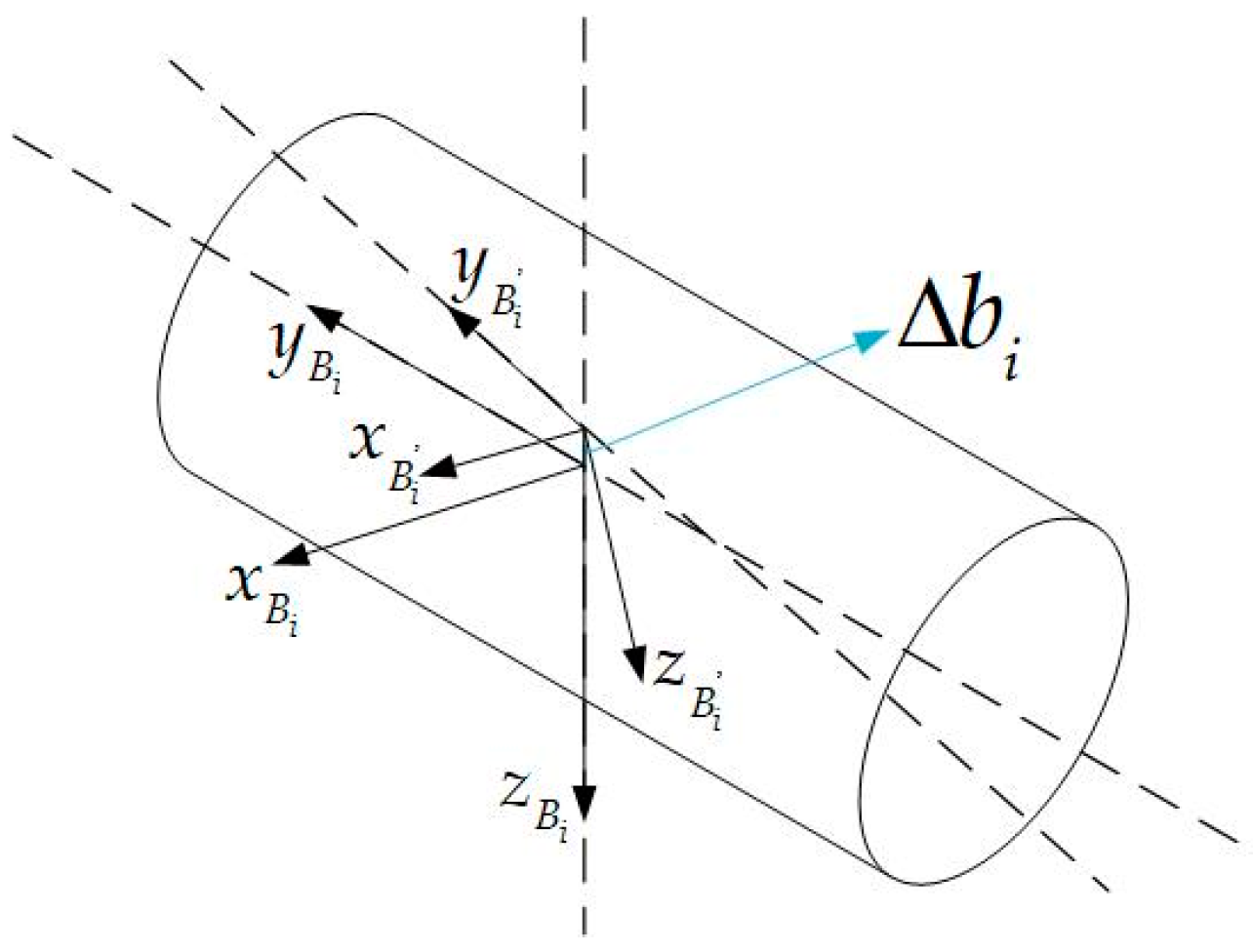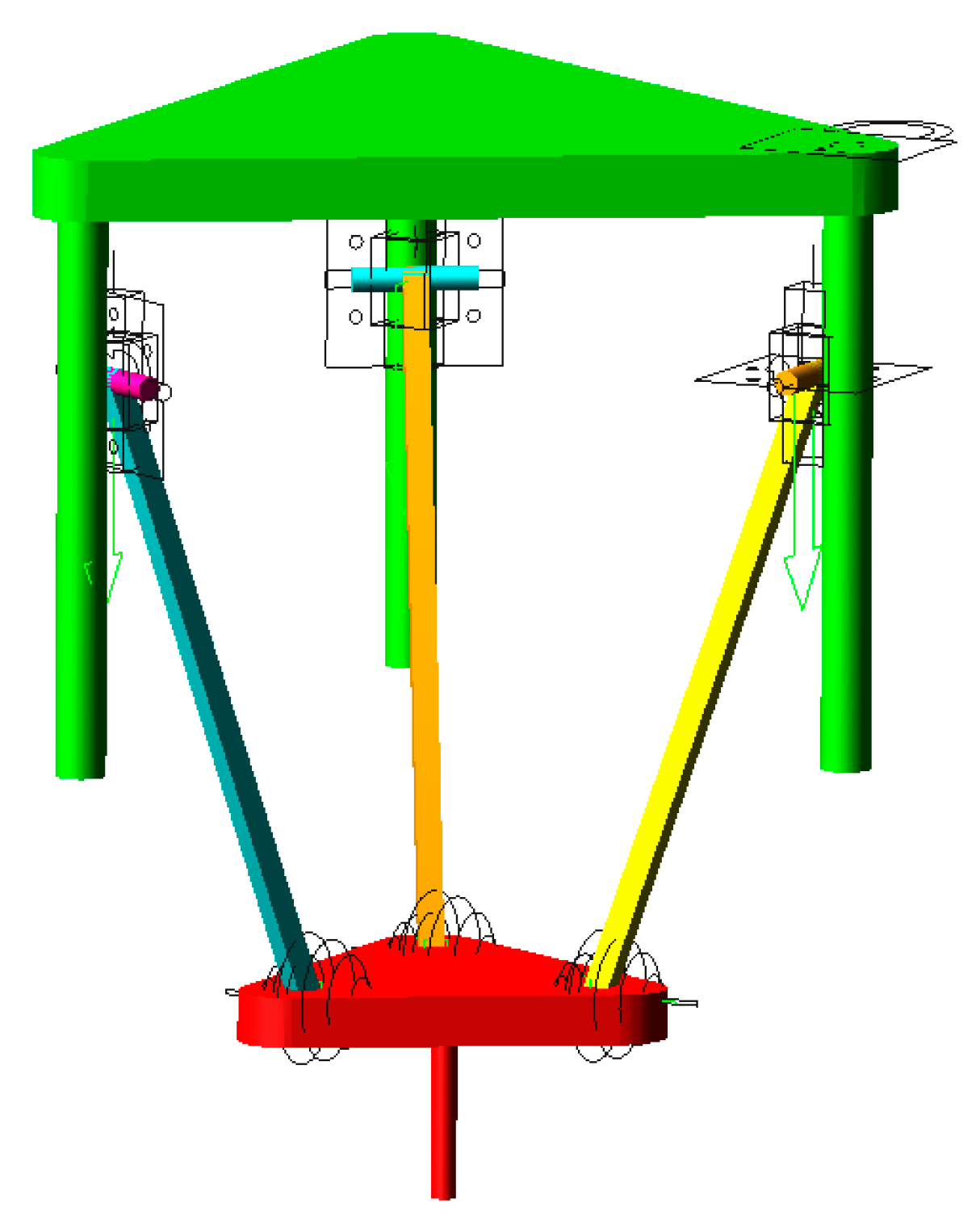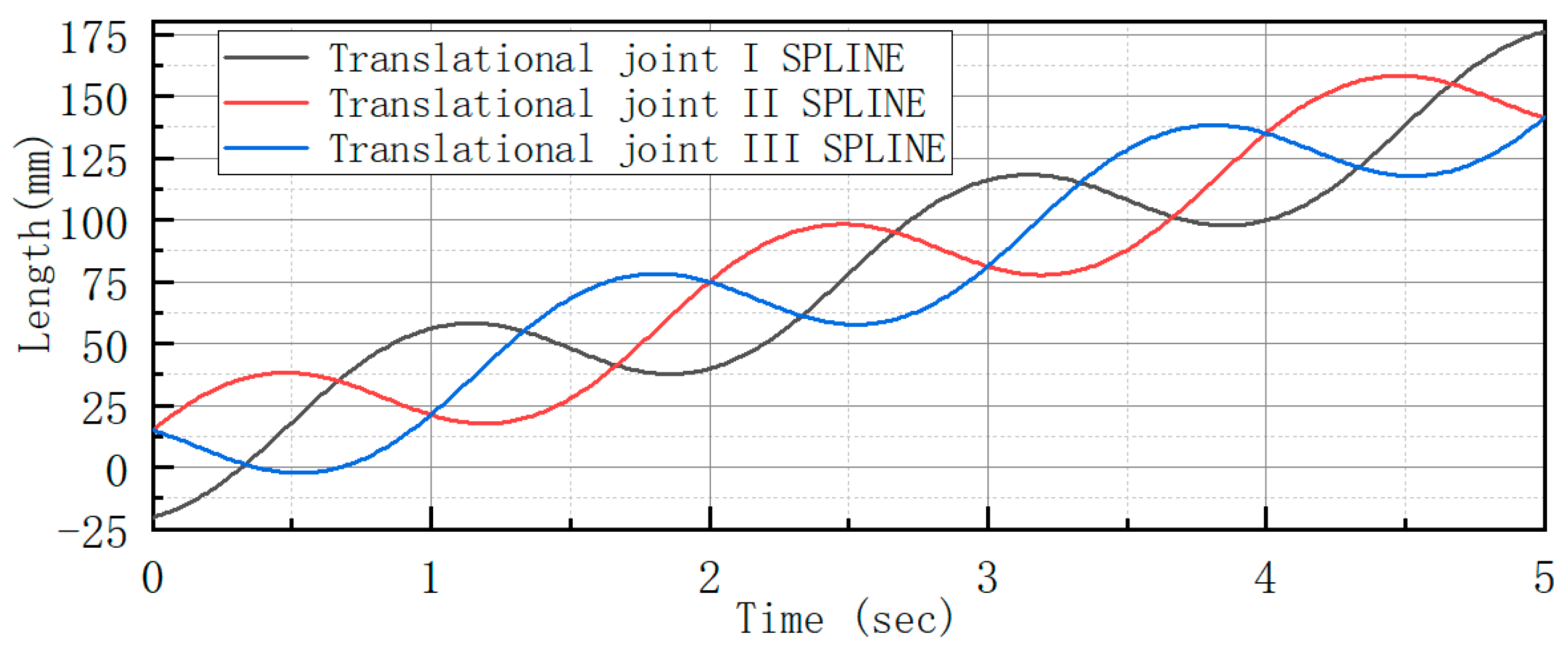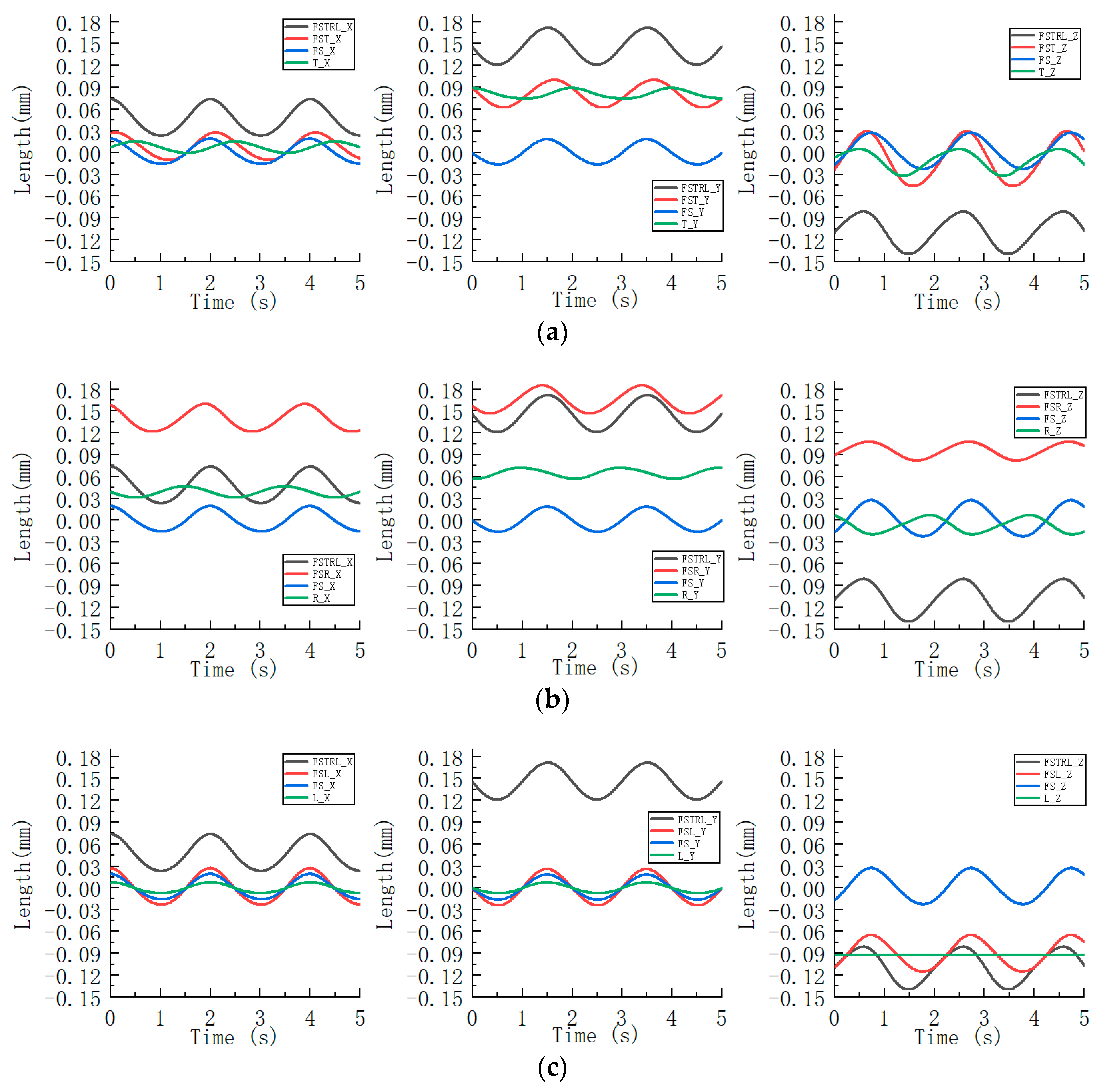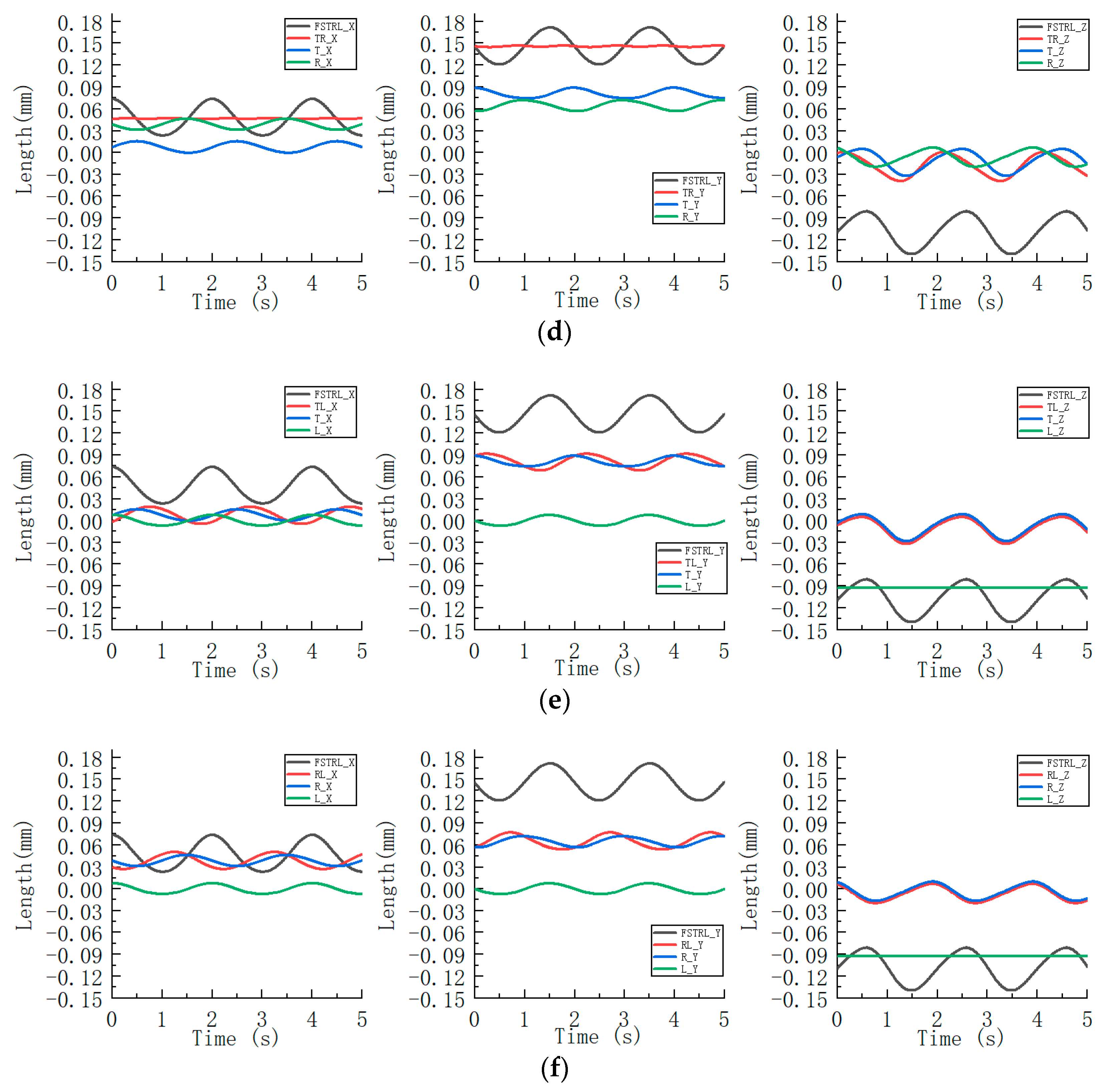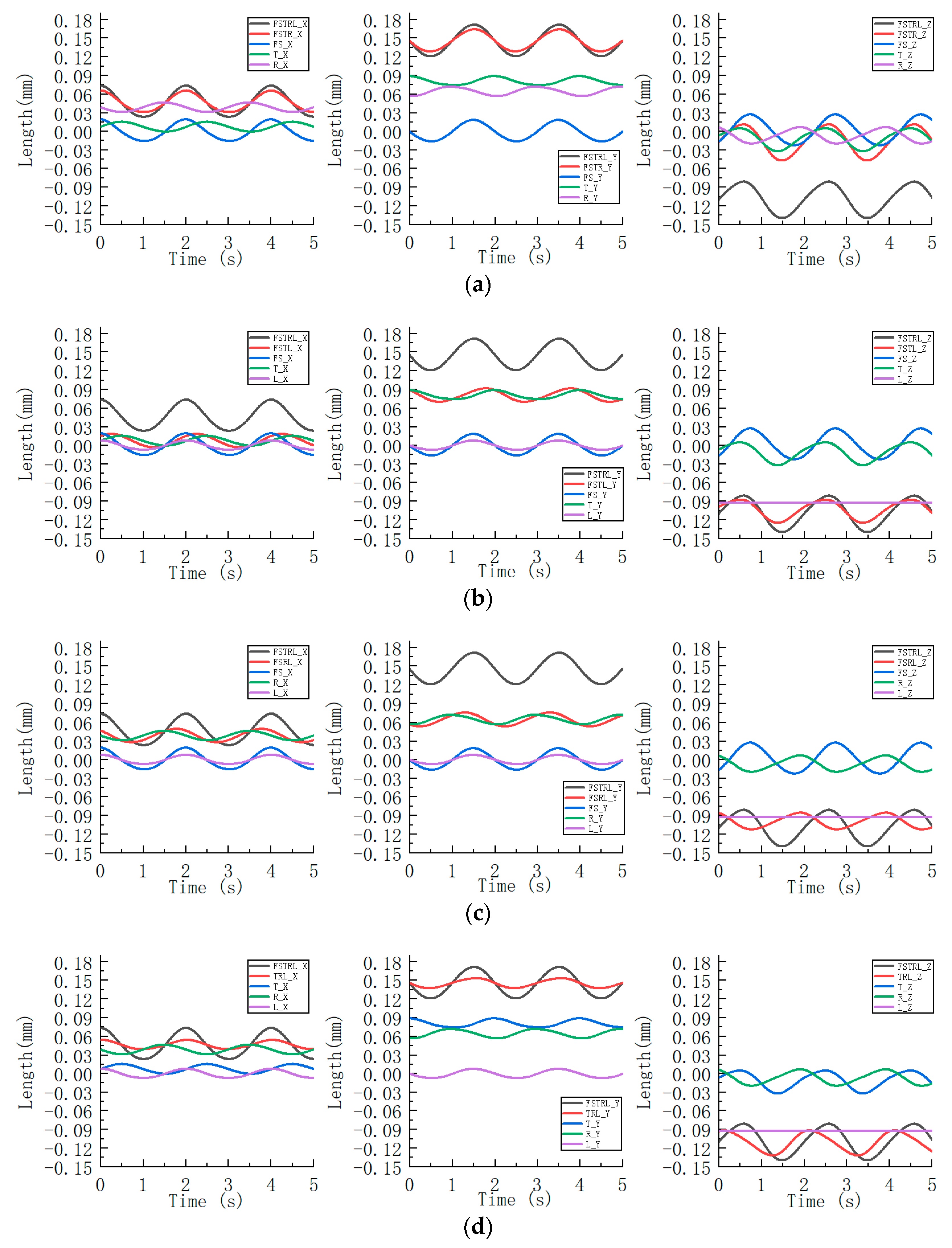5.2.1. Effect of a Single Geometric Error Source on Robot End Position Error
Based on the geometric error sources analyzed above and the established error mapping model, error analysis is performed on the separated compensable error sources. Identify the compensable error sources that have the most significant effect on the robot’s end posture error. Here, we will investigate how a hybrid robot parallel mechanism’s hinge point position error of the fixed and dynamic platforms, the translational joint initial position error, and the revolute joint gap error affect the robot end of the robot.
Assuming that the error of each geometric structure parameter of the mechanism is 0.1 mm, the key positions of the parallel mechanism are parameterized by using the error parameters. These key positions are the hinge point position of the dynamic fixed platform, the initial linkage length of the driven linkage, the translational joint initial position, and the revolute joint gap. Then, the kinematic simulation of the robot is performed to measure the displacement trajectory of the robot’s end. Compare the motion trajectories containing errors with the original motion trajectories not containing errors, and finally derive the effect of each error source on the robot’s end motion.
When only dynamic and fixed platform hinge position error (
) is considered, the robot end motion trajectory error curve is shown in
Figure 8. (FS_X represents the error curve of the hinge point position error of the dynamic fixed platform on the robot end in the X-direction):
When only the translational joint initial position error (
) is considered, the robot end motion trajectory error curve is shown in
Figure 9 (T_X represents the error curve of the translational joint initial position error on the robot end in the X-direction):
When only the revolute joint gap error (
) is considered, the robot end motion trajectory error curve is shown in
Figure 10 (R_X represents the effect of the revolute joint gap error on the X-direction of the robot end):
When only the rod length error (
) is considered, the robot end motion trajectory error curve is shown in
Figure 11 (L_X represents the effect of the rod length error on the X direction of the robot end):
Above is the error profile of each error simulated by ADAMS. As can be seen from
Figure 8, the maximum error of the dynamic and fixed platform hinge position on the end of the robot is 0.0352 mm in the X direction of motion, 0.035 mm in the Y direction, and 0.0501 mm in the Z direction. As can be seen from
Figure 9, the maximum error of the initial position error of the moving sub on the end of the robot is 0.0157 mm in the X direction of motion, 0.0144 mm in the Y direction, and 0.0373 mm in the Z direction. As can be seen from
Figure 10, the maximum error of the revolute joint gap error on the end of the robot is 0.0154 mm in the X direction of motion, 0.015 mm in the Y direction, and 0.0268 mm in the Z direction. As can be seen from
Figure 11, the maximum error of the rod length error on the end of the robot is 0.0155 mm in the X direction of motion, 0.0154 mm in the Y direction, and 0.0003 mm in the Z direction. As a result, it can be concluded that the dynamic and fixed platform hinge position error has the most significant effect on the robot end position, and the rod length error has the least effect on the Z direction of the end motion. From the four sets of plots, it can be seen that when the robot’s end trajectory changes regularly, the effect of each error source on the end position also changes into a regular pattern.
To verify the influence of each error source on the position of the robot end, the simulation was verified several more times in the error (0.1 mm–0.5 mm) range. When the error is 0.3 mm, the maximum error of the dynamic and fixed platform hinge position on the end of the robot in X, Y, and Z directions are 0.1057 mm, 0.1049 mm, and 0.1504 mm, respectively; the maximum errors of the initial position error of the moving sub to the end of the robot in the X, Y, and Z directions are 0.0473 mm, 0.0433 mm, and 0.1118 mm, respectively; the maximum error of rotating sub gap error on the end of the robot in X, Y, and Z directions is 0.0461 mm, 0.045 mm, and 0.084 mm respectively; the maximum error of the rod length on the end of the robot in X, Y, and Z directions is 0.0525 mm, 0.0526 mm, and 0.00032 mm, respectively. When the error is 0.5 mm, the maximum error of the dynamic and fixed platform hinge position on the end of the robot in the X, Y, and Z directions are 0.1761 mm, 0.1748 mm, and 0.2508 mm, respectively; the maximum errors in the X, Y, and Z directions of the initial position error of the moving sub for the end of the robot are 0.0789 mm, 0.0722 mm, and 0.1862 mm, respectively; the maximum errors of the rotating sub gap errors on the X, Y, and Z directions at the end of the robot are 0.0768 mm, 0.075 mm, and 0.1341 mm, respectively; the maximum error of the rod length on the end of the robot in X, Y, and Z directions is 0.0876 mm, 0.0878 mm, and 0.0005 mm, respectively. From this, it can be concluded that the dynamic and fixed platform hinge position error has the most significant effect on the end position of the robot; the rod length error is second only to the dynamic and fixed platform hinge position error in the X and Y directions of the end motion, but has the least effect in the Z direction; and the effect of the initial position error of the translational joint and the revolute joint gap error on the end position is basically equivalent.
The equation of the motion trajectory of the end of the parallel mechanism part is set in space again. The simulation is performed again using the same method steps.
Similarly, setting the error of each structural parameter to 0.1 mm, the following error curves can be obtained by simulating the robot using the same methodological steps.
When only moving and fixed platform hinge position error (
) is considered, the robot end motion trajectory error curve is shown in
Figure 12:
When only the initial position error (
) of the translation is considered, the robot end motion trajectory error curve is shown in
Figure 13:
When only the revolute joint gap error (
) is considered, the robot end motion trajectory error curve is shown in
Figure 14:
When only the rod length error (
) is considered, the robot end motion trajectory error curve is shown in
Figure 15:
Based on the error curve figures derived from the above simulation, the same conclusion can be drawn for the two spatial motion trajectories. The dynamic and fixed platform hinge position error has the most significant effect on the end position of the robot, and the rod length error has the least effect in the Z direction of the end motion. The effect of the translational joint initial position error is smaller than the rod length error, and the revolute joint gap error is smaller than the effect of the translational joint initial position error, but the effects of the two error sources are basically equal. The error curve simulated by the second trajectory equation shows that the magnitude of the error curve is gradually increasing, so it can also be concluded that the effect of each error source on the end position of the robot will increase with the increase of the end trajectory.
5.2.2. Effect of Coupling Multiple Geometric Error Sources on Robot End Position Error
The geometric errors of the parallel robot are coupled with each other to form the spatial error of the whole machine. To analyze the effect of the coupling between the geometric error terms on the robot’s end position based on the conclusions drawn in
Section 5.2.1, this summary investigates the coupling of the error sources. Separately, all error sources, two error sources, and three error sources are coupled, and the calculated results are compared with the results of coupling all error sources. The results of the calculations are shown in
Figure 16,
Figure 17 and
Figure 18, respectively.
The error profiles after coupling all error sources are plotted in
Figure 16.
As can be seen from
Figure 16, for the X and Y coordinates of the robot end, the position coordinate errors of the robot end caused by the translational joint initial position error and the revolute joint gap error are in opposite directions, so the two can basically cancel each other out. The position coordinate errors of the robot end caused by the remaining two errors (the dynamic and fixed platform hinge position error and the rod length error of the slave linkage) are basically in the same direction, so the comprehensive position error increases after superposition. As for the Z coordinate of the robot end, the influence of the translational joint initial position error on the Z coordinate of the robot end is greater than that of the revolute joint gap error, so the two cannot cancel each other. Among them, the direction of the position coordinate error of the robot end caused by the translational joint initial position error, the dynamic and fixed platform hinge position error, and the rod length error are basically the same. After superposition, the comprehensive position error increases. In the figure, it can be seen that the coupling of several error sources is not a simple superposition, and the error offset phenomenon can occur during the coupling of error sources. (In the legend, FS represents the dynamic and fixed platform hinge position error, T represents the translational joint initial position error, R represents the revolute joint gap error, L represents the slave linkage rod length error, and FSTRL represents the error after coupling the four error sources, and the same representation is applied in the subsequent legends.)
The error profile after coupling the two error sources is plotted in
Figure 17.
In
Figure 17, from
Figure 17a, it can be seen that after the coupling of the dynamic and fixed platform hinge point position error (
) and the translational joint initial position error (
), for the X, Y, and Z coordinates of the robot end, the change patterns of the posture error curves at the robot end caused by the two errors are basically the same, and the directions of the posture errors at the robot end caused by them are also basically the same most of the time. After the superposition, the integrated posture error at the robot end increases. The dynamic and fixed platform hinge point position error dominates. These two error sources coupled in the Z coordinate have a larger fluctuation in the integrated position error curve than the fluctuation in the integrated position error curve of all the error sources coupled.
In
Figure 17, from
Figure 17b, it can be seen that after the coupling of the dynamic and fixed platform hinge point position error (
) and the revolute joint gap error (
). For the X-coordinate and Y-coordinate of the robot end, the change rule of the posture error curve of the robot end caused by the two errors is basically the same, and the direction is also basically the same for most of the period. So, after the superposition, the integrated posture error of the robot end is increased. The dynamic and fixed platform hinge point position error dominates. For the Z coordinate at the end of the robot, the two errors cause the positional errors at the end of the robot to be in opposite directions, and the integrated positional errors are reduced after superposition. The integrated positional errors in X, Y, and Z directions are smaller than the integrated positional errors after coupling all error sources.
In
Figure 17, from
Figure 17c, it can be seen that after the coupling of the dynamic and fixed platform hinge point position error (
) and the slave linkage rod length error (
). For the X and Y coordinates of the robot end, the two errors cause the same direction of the posture error of the robot end, and the integrated posture error increases after the superposition. Since the error of the slave linkage length is very small in the Z coordinate, the changing pattern of the integrated posture error after superposition is similar to the posture error curve of the dynamic and fixed platform hinge point position errors. For the three coordinates, the influence of the dynamic and fixed platform hinge point position errors is dominant.
In
Figure 17, from
Figure 17d, it can be seen that after the translational joint initial position error (
) and the revolute joint gap error (
) are coupled, for the X and Y coordinates of the robot end, the two errors cause the position error of the robot end to be in opposite directions. After superposition, the integrated position error is significantly reduced and tends to a horizontal line. For the Z coordinate at the end of the robot, the error increases after coupling because the effects of the two errors are not cancelable. The integrated positional errors in X, Y, and Z directions are smaller than the integrated positional errors after coupling all error sources.
In
Figure 17, from
Figure 17e, it can be seen that after the translational joint initial position error (
) is coupled with the slave linkage rod length error (
), for the X and Y coordinates at the end of the robot, the integrated positional error does not change significantly after the two errors are coupled. For the Z coordinate of the robot end, the error curve tends to be in a horizontal line because of the small influence of the rod length error in the Z direction. Therefore, the change rule of the integrated position error curve after the coupling of the two errors is similar to the change rule of the error curve caused by the translational joint initial position error and tends to coincide. For the three coordinates, the influence of the translational joint initial position error dominates.
In
Figure 17, from
Figure 17f, it can be seen that after coupling the revolute joint gap error (
) with the slave linkage rod length error (
), for the X and Y coordinates at the end of the robot, the integrated posture error does not change significantly after the two errors are coupled. For the Z coordinate at the end of the robot, the rod length error has little effect in the Z direction and tends to be a horizontal line. Therefore, the change rule of the integrated position error curve after the coupling of the two errors is similar to the change rule of the error curve caused by the revolute joint gap error and tends to overlap. The integrated posture error after coupling the translational joint initial position error and rod length error and the integrated posture error after coupling the revolute joint gap error and rod length error are basically comparable in the X and Y coordinates at the end of the robot, but in the Z coordinate direction, the integrated posture error of the former has a more significant effect on the end of the robot.
The error profile after coupling the three error sources is plotted in
Figure 18.
In
Figure 18, from
Figure 18a, it can be seen that after the coupling of the dynamic and fixed platform hinge position error (
), the translational joint initial position error (
) and the revolute joint gap error (
), for the X and Y coordinates of the end of the robot, the error curves caused by the translational joint initial position error and the revolute joint gap error are in opposite directions, so the effects can be canceled out. So, the changing pattern of the integrated posture error curve after the coupling of the three errors is similar to that of the dynamic and fixed platform hinge position errors. For the Z coordinate of the robot end, the integrated position error increases after superposition because the direction of the position error curve of the robot end is caused by the dynamic and fixed platform hinge position error, and the translational joint initial position error is basically the same.
In
Figure 18, from
Figure 18b, it can be seen that after the coupling of the dynamic and fixed platform hinge position error (
), the translational joint initial position error (
) and the rod length error (
) of the slave linkage, for the X and Y coordinates of the robot end, the direction of the posture error curve of the robot end caused by the dynamic and fixed platform hinge position error and the rod length error is basically the same, but the translational joint initial position error is opposite to the other two errors. Therefore, the integrated position error after coupling is smaller than the position error of the robot end caused by the dynamic and fixed platform hinge position errors. For the Z coordinate at the end of the robot, the integrated posture error after the coupling of the three error sources is smaller than the posture error at the end of the robot caused by the dynamic and fixed platform hinge position errors. The integrated positional error in X, Y, and Z directions is smaller than the integrated posture error after coupling all error sources.
In
Figure 18, from
Figure 18c, it can be seen that after the coupling of the dynamic platform hinge position error (
), revolute joint gap error (
), and slave rod length error (
), for the X and Y coordinates of the end of the robot, the changing pattern and direction of the posture error curve at the end of the robot caused by the dynamic platform hinge position error and the slave linkage rod length error are basically the same, but the revolute joint gap error is in the opposite direction of the error curve caused by the former two error sources. Therefore, the integrated posture error after superposition is smaller than the effect of the single error source of the dynamic platform hinge position error. For the Z coordinate at the end of the robot, the integrated positional error is reduced after superposition because the rod length error has little effect, and the direction of the position error curve at the end of the robot is caused by the revolute joint gap error, while the dynamic and fixed platform hinge position errors are opposite. In the three directions of the robot end, the integrated posture error after coupling these three error sources is significantly smaller than the integrated posture error after coupling all error sources.
In
Figure 18, from
Figure 18d, it can be seen that after the translational joint initial position error (
), the revolute joint gap error (
) and the slave linkage rod length error (
) are coupled. For the X and Y coordinates of the robot end, in the opposite direction of the position error curve of the robot end caused by the translational joint initial position and revolute joint gap error. So, the integrated posture error of the three errors after superposition is reduced. For the Z coordinate at the end of the robot, the rod length error has little effect, and the position error curve at the end of the robot is caused by the translational joint initial position error, and the rotating sub-gap error is basically in the same direction for most of the time. Therefore, the integrated position error increases after the superposition of the three errors.
